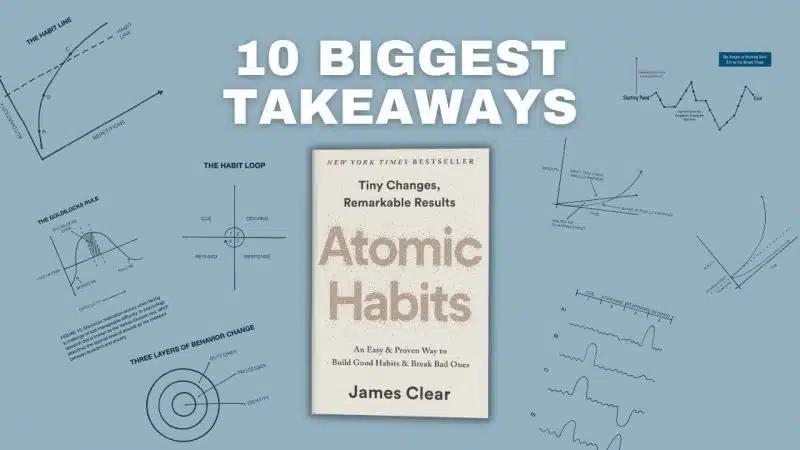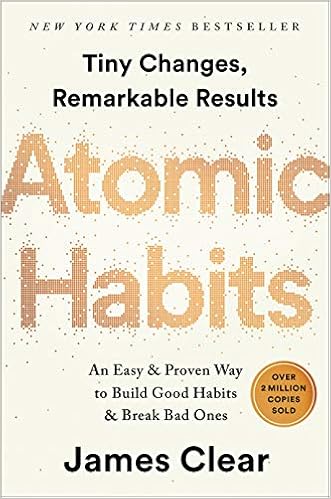I'm going to keep the "review" aspect of this article short and sweet. Here's a bold statement...Atomic Habits is the best non-fiction book I've ever read.
The concept might seem simple on the surface, but this book goes well beyond the idea that good habits are good and bad habits are bad. There is a surplus of takeaways and insights that will help you adopt future habits, break bad habits and achieve continuous improvement in all aspects of your life and work.
The productivity and self-improvement space is littered with "me-too" books on habit building, but this one is different.
Not only is the information about building better habits shared in a way that is extremely easy to understand, James Clear also makes the book wildly entertaining.
For example, his story about his baseball injury at the beginning of the book will have you on page 20 before you even noticed a minute tick by.
I've reviewed a lot of books on this channel, so I don't say this lightly. Atomic Habits is truly the most impactful book that can help literally any person who wants to improve their life in any way imaginable.
My most gifted book. An absolute must read for anyone who wants to succeed at anything.
So, instead of splitting hairs and further reviewing a book that I see as nearly flawless, I'm just going to jump into the 10 biggest takeaways from Atomic Habits. This won't be a full Atomic Habit's summary, but it will be the biggest pieces of it.
After reading this, you'll come away with much of the meat of the book, but I still suggest reading it from cover to cover when you get time.
Atomic Habits Cheat Sheet
I expand on each of the 10 Atomic Habits listed in the Atomic Habits cheat sheet below in the rest of the blog post, but I quickly summarized the biggest ones in this little infographic.
#1 Winners and Losers Have the Same Goals
Having goals isn't enough. Almost everyone has them.
It's having the systems in place, rooted in good habits, that separates winners from losers.
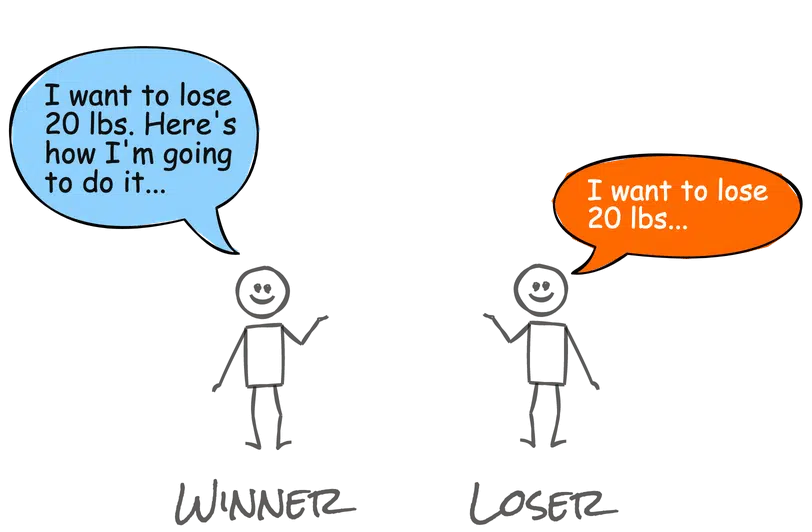
Losers have the wrong systems in place (or no systems at all).
Winners adopt habit formation that makes their goal attainable.
To "lose weight" is a goal, but without systems and good habits, it is pointless.
All self improvement is rooted in good habits directed towards goals. Goals on their own are meaningless, without habit formation that drives us closer to them.
#2 The Compound Interest of Small Habits
We all want shortcuts, quick fixes and overnight results. Small steps are not sexy or nearly as gratifying as mammoth leaps towards a lofty result.
However, small steps are the true path to them.
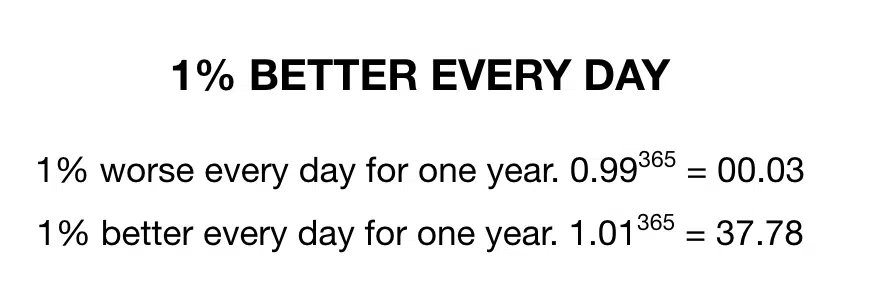
The 1% better everyday concept shows that by improving at something, just 1% every day results in a massive increase of a near 38X improvement over just 1 year.
Clear describes this as "interest of self improvement" or "compound interest of self."
Note: Quantifying certain goals can be tricky (how do you measure of goal of becoming a better speaker, for example). Don't get bogged down by that. Trust that the concept holds true, regardless of the measurables.
Likewise, bad habits repeat and can have the same effective in reverse. Getting 1% worse everyday leads to a decrease to .03X over that same year.
Continuous improvement through positive habit forming leads to massive results at scale. Fortunately, the scale isn't as far away as it might seem (see graph below).

I built a custom worksheet for the 1% better everyday method, you can check it out here.
Small habits shape long term change.
#3 Identity Based Habits
We're far more likely to stick to a particular habit if it is tied to our self-identity.
Humans like to remain consistent to their self identities. If we identify as a kind person, for example, it is difficult for us to act unkindly to others.
If we identify as hard working, it harms our self image if we don't work hard.

Here are some examples of what self-identifying habits look like.
- We are more likely to adopt healthy habits if we identify as "someone who always takes care of their body."
- We are more likely to be on time when we identify as "someone who is always early."
- We are more likely to quit smoking for good when we identify as a non-smoker vs. a former smoker.
These types of habits rely on intrinsic motivation and revolve around maintaining consistency with the type of person we think we are and wish to be.
Clear writes that identity is the first of three layers of behavior change.

All lasting behavior change starts with a shift in identity to one that aligns with the desired behavior.
#4 The Goldilocks Rule and Peak Motivation
Humans experience peak motivation when a task is just at the edge of their skills. It is obtainable but requires effort. If something is too easy, we enjoy it less. If it's too difficult, we enjoy it less.

"Maximum motivation occurs when facing a challenge of just manageable difficulty. In psychology research this is known as the Yerkes-Dodson law, which describes the optimal level of arousal as the midpoint between boredom and anxiety." - James Clear Atomic Habits [Figure 15]
The key takeaway here is to always push your goals just outside of your reach. When you reach them, push them slightly beyond that and repeat until you die
#5 The Plateau of Latent Potential
This is a concept that I reference regularly throughout my content when discussing business growth.
It's the idea that results almost always take more time than we expect but once we achieve a certain level, growth begins to quickly exceeds our initial expectations.

It's like "The rich get richer" with an addendum that "they get disappointed first."
The key takeaway is to not let slow growth deter you.
Assume that results will take longer than you'd like but keep your eye on those exponential gains that are achieved once we've crossed out of the "valley of disappointment."
#6 The 4 Laws of Creating Good Habits and Breaking Bad Habits
The book circles around the 4 laws of developing a good habit and the 4 laws of breaking a bad habit.
They form a "habit loop" (see image below).
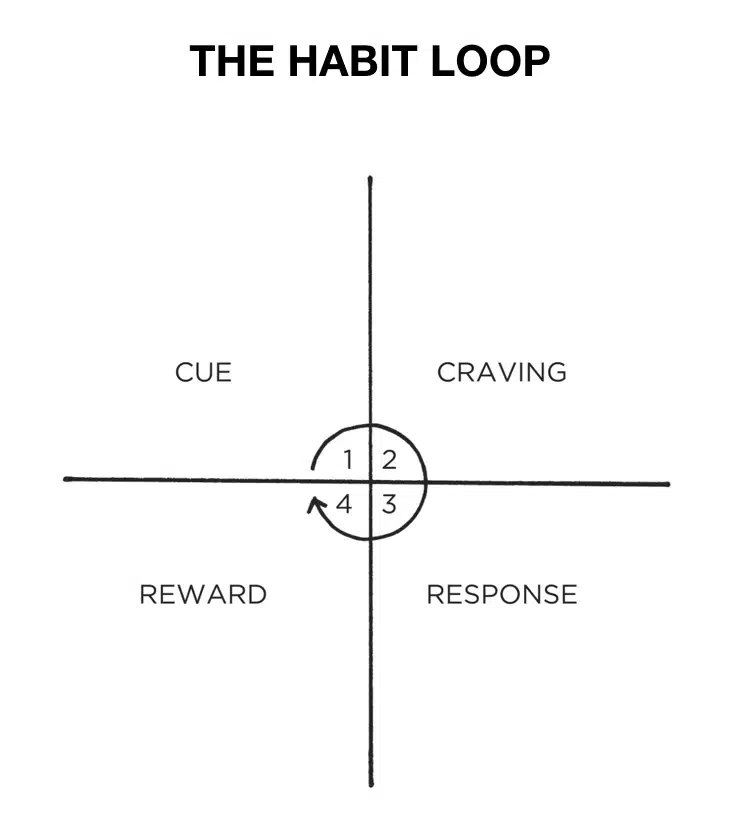
How to Create a Good Habit
- 1st Law (Cue): Make it obvious
- 2nd Law (Craving): Make it attractive
- 3rd Law (Response): Make it easy
- 4th Law (Reward): Make it satisfying
The inverse of this process can be used to break bad habits.
How to Break a Bad Habit
- Inversion of 1st Law (Cue): Make it invisible
- Inversion of the 2nd Law (Craving): Make it unattractive
- Inversion of the 3rd Law (Response): Make it difficult
- Inversion of the 4th Law (Reward): Make it unsatisfying
Concepts like this throughout the book are simple enough to grasp, but Clear expands deeply on each with statistics, stories and real world examples that hammer home the points.
#7 Habit Stacking
The hardest part about developing a good habit is getting started. Once we have started a habit ritual, it's much easier to keep going.
This is why "habit stacking" or combining multiple "tiny habits" together is so powerful.

So, we should combine similar habits together whenever possible and perform them back to back.
I write about my own morning habit stacks here (although they aren't perfectly in the spirit of how James Clear suggests we stack habits).
Here are some suggestions for creating a good evening habit stack as well.
#8 The Compound Effect of Small Decisions
Whether we have a good day or a bad day is decided by the collection of small decisions we make throughout our day.

Although it seems extremely simple, it is a good reminder that small things do have a large impact at scale.
#9 Environment > Motivation and Willpower
Motivation is not constant. Neither is willpower.
Even the most successful people on the planet deal with the endless ebb and flow of moments of high and low motivation and willpower.
Motivation and willpower, for all of the love and attention they get in the self development space, are in fact, overrated.
We can't stabilize willpower or motivation, but we can make our environment consistent and predictable.
In order to maximize our odds of success, we need to operate in an environment that accelerates our results rather than hinders them.
Clear outlines three ways that we can cultivate these positive environments.
- Automate good decisions
- Get in the flow
- Remove negative influences or temptations and make bad habits impossible
Setting ourselves up in positions that don't require extreme willpower or motivation will lower our dependency on them and dramatically boost our chances of success.
If we make bad habits impossible, we don't need to rely on willpower or motivation.
Read more about the power of environment here.
#10 The 2 Minute Rule
Last but not least, the 2 minute rule. This states that new habits should take less than 2 minutes to perform.
Regardless of the size of the goal, it should always start with something that can be completed in under 2 minutes. That doesn't mean that the entire task takes under 2 minutes, but the first step should.
This allows us to ride the momentum of small cues. Starting the habit leads to step 2 (cravings) to continue.
The 2 minute rule allows us to master the art of "showing up," which is more than half of the battle.
Here are the examples Clear makes showing larger habits broken down into the 2 minute rule.
- Read before bed each night -> Read one page
- Do 30 minutes of yoga -> Take out my yoga mat
- Study for class -> Open my notes
- Fold the laundry -> Fold one pair of socks
- Run three miles -> Tie my running shoes

